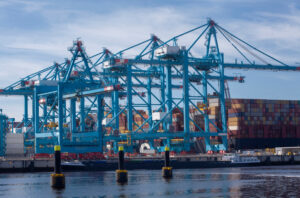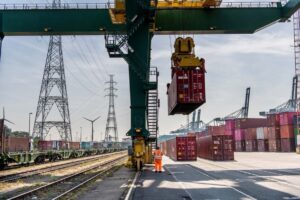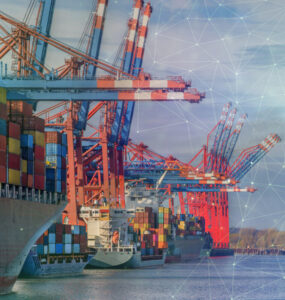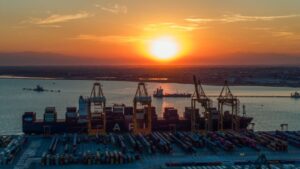Blog contribution by DP World
The human diet is changing. And it’s changing fast. Whether it’s for health reasons, environmental reasons or simply for more likes on Instagram posts, the food that populates our plates is coming from an increasingly diverse array of sources and technologies.
One foodstuff that is making its way onto menus and into the headlines is lab-grown meat. In 2013, lab-grown meat cost over $300,000 per serving, making it an extremely expensive alternative to livestock meat.
Yet, as with most technological innovations, achieving scale in production lead to the cost reducing at a rapid rate. By 2015, the cost per serving had fallen to $11, leading to speculation that so-called “clean meat” could be commercially available by the end of this year.
The technology that makes lab-grown meat possible, known as cellular agriculture, is spreading globally and is enticing and attracting businesses from Silicon Valley startups, to agricultural behemoths.
This, combined with vegan and imitation meat products capturing ever larger shares of the market, show the huge potential for “clean meat” to grow alongside clean eating habits and healthy lifestyles.
While still dearer than your average beef burger, the process of creating lab-grown meat forgoes many of the negative impacts of the meat industry, ranging from methane emissions, deforestation and biodiversity loss due to grazing and animal welfare concerns.
The impact of meat production, of course, goes beyond production. Logistically, the supply chains for poultry and meat products are incredibly long and complex, requiring temperature-controlled refrigeration and other specialist requirements that incur extra costs and multiple risks for operators.
There are a huge number of touch points for meat across the supply chain, from farm to fork. Yet, if we are to fully investigate the footprint of meat, the supply chain actually extends further back to include a full life cycle analysis.
Broadly speaking, we can divide the process into several distinct categories: farm operations, feedlot operations and packing, processing and retail operations.
All of this combines to give beef a carbon footprint of 22kg CO2 equivalent per kg of live weight. In addition to this, meat also has an effect in terms of cost incurred, with each touchpoint and additional mile travelled adding to the financial exposure of supply chain operators.
The UN’s Food and Agricultural Organisation (FAO) projects that meat production in 2025 will be 16% higher than 2015 levels to meet growing demand.
Read a Port Technology technical paper by DP World on linking the supply chain
Rising incomes are positively correlated with rising meat consumption, and as economies like China continue to grow, so does their appetite for meat, as it is synonymous with more wealthy lifestyles.
However, lab-grown meat offers a new paradigm for which both ports and the planet can benefit. At DP World, we have been long emphasising the benefits of a port centric approach to logistics, and the “clean meat” revolution falls neatly into this concept.
Moreover, significant positive synergies can be generated by combining the two. All the benefits of this dawning era in manufacturing can only be attained if companies reassess and consolidate their supply chains.
A lesser need for traditional warehouse space, increased capital mobility due to advances in technology and the ability to manufacture-on-demand, creates multiple incentives for firms to bring their manufacturing base closer to key logistics hubs, such as ports.
Port centricity, of course, offers reduced delivery times. The quicker you can get your goods to the port, the quicker they will be dispatched to the next stage in the supply chain, be it directly to the customer or a retail facility.
Shorter lead times on each good makes the supply chain more responsive to the ever-growing demand for faster, cheaper delivery.
In addition to this, by basing your productive base next to your logistics hub, you compress the manufacturing side of the supply chain by removing several steps or touch points, which therefore reduces cost.
The growing global demand for meat, combined with advances in cellular agriculture and additive manufacturing, make port-centric logistics operations incredibly attractive to this emerging and exponential industry.
If the world is to reign in its carbon emissions to achieve the reductions outlined in the Paris Agreement, then humanity needs to find – and scale up – clean sources of both food and energy.
Renewable energy and lab-grown meat can perhaps fulfil these lofty promises, but they both need logistical network to get them to the end-user.
Port operators need to partake in some future gazing and adjust their operations accordingly. As explained, there is both an economic and social imperative to do so, which – at DP World – we take very seriously. In the case of lab-grown, there might even be a taste imperative.
About the author:
Dirk van der Bosch is the Commercial Director of Europe at DP World Europe & Russia, which owns 10 ports and 5 inland terminals across the continent, employing more than 4,000 employees across 37 countries.
DP World is a global terminal operator at 78 ports in 42 countries. The group handles approximately 9% of the world’s container trade and in 2017, globally DP World handled 70 million TEU.
DP World Europe and Russia services include container stuffing and de-stuffing, VGM – container weighing, onsite empty depot, logistics parks, freight forwarding, warehousing, container handling, break bulk, cruise ro-ro car, multi-purpose and intermodal infrastructure.














